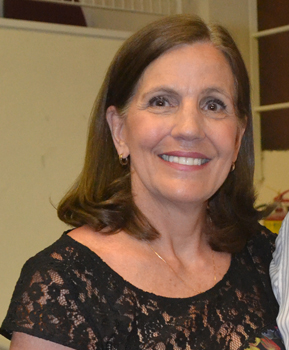
Jennifer Craig-Norton
From her master’s thesis to the Holocaust workshops she leads for students in England, the Visual History Archive has always been an important part of Jennifer Craig-Norton’s work.
Craig-Norton currently does educational outreach for the Parkes Institute for the Study of Jewish/non-Jewish Relations at the University of Southampton. As an Outreach Fellow, she conducts workshops and seminars for Sixth Form students doing A Levels in History (and English), adult continuation learner courses and the lectures and study days for the general public. She uses testimony from the Visual History Archive for all these programs.
With a background as a high school history and English teacher in Northern California, Craig-Norton has been involved in Holocaust education since 1999, when she was accepted as a United States Holocaust Memorial Museum Teacher Fellow. Since 2005, she has been a member of the museum’s Regional Education Corps. She has also consulted about the Holocaust for the College Board’s AP European History test and Prentice Hall and McGraw Hill’s materials about anti-Semitism.
She also consulted for USC Shoah Foundation’s educational website IWitness before its launch in 2012.
Craig-Norton wrote her master’s thesis at Sacramento State University and PhD at University of Southampton about the Kindertransport, and used testimony from the Visual History Archive in both papers. She found case files of over 100 children who had been brought to England on three Kindertransports from Zbąszyń and other locales in Poland after they and their families had been deported from Germany October 28-29, 1938, and looked up each child in the Visual History Archive. Fourteen had given testimony, as well as several others who were relatives or witnesses. Craig-Norton said their testimony formed a significant and important part of her research and analysis.
In her Holocaust workshops at the Parkes Institute, Craig-Norton assigns different theme each year, such as “Journeys” last year and “Keeping the Memory Alive” this year. The workshops are one to three hours long and usually coincide with Holocaust Memorial Day commemorations on January 27, although Craig-Norton held a workshop on Anne Frank Memorial Day which had about 80 attendees.
Testimony is a vital part of each workshop. Craig-Norton has used testimony of Cornelia Aaron-Swaab, Alexandra Mayzel Lauterbach, Michele Cohen-Rodriguez, Judith Becker and Salomon Carlebach to illustrate the Kindertransport and other topics.
Craig-Norton said students usually attend the workshops voluntarily and are “uniformly moved and affected” by testimony. Their written responses to what they have watched and learned demonstrate just how much they are affected by the stories of the survivors; for example, she remembers several beautiful poems students have written about Aaron-Swaab’s testimony.
“Testimony humanizes and contextualizes the Holocaust in ways that other media cannot, and helps students to incorporate the material they are learning more deeply and sensitively,” she said.
The Visual History Archive has been a vital part of her research, but Craig-Norton said its importance to her teaching increases exponentially each year as fewer survivors are able to come speak to students. Soon, testimony will be the only way students can hear survivors speak about their stories and memories.
“All the material that I use with student groups, including photos, written testimony, contemporaneous letters and documents is meaningful to young learners and has the ability to move them, but I have found that when such lessons are accompanied by even a few short, selected testimony clips, the material comes alive for them in ways that paper documentation cannot convey,” she said.